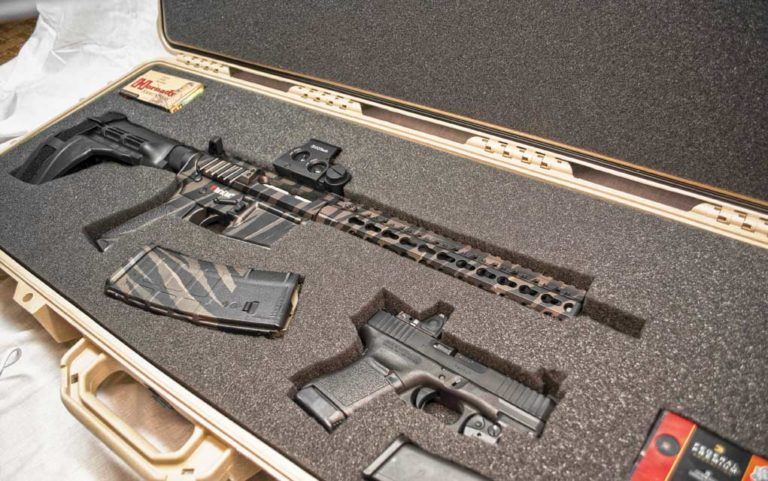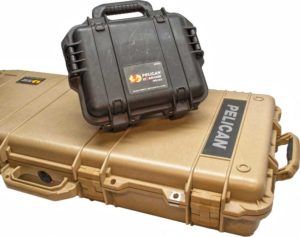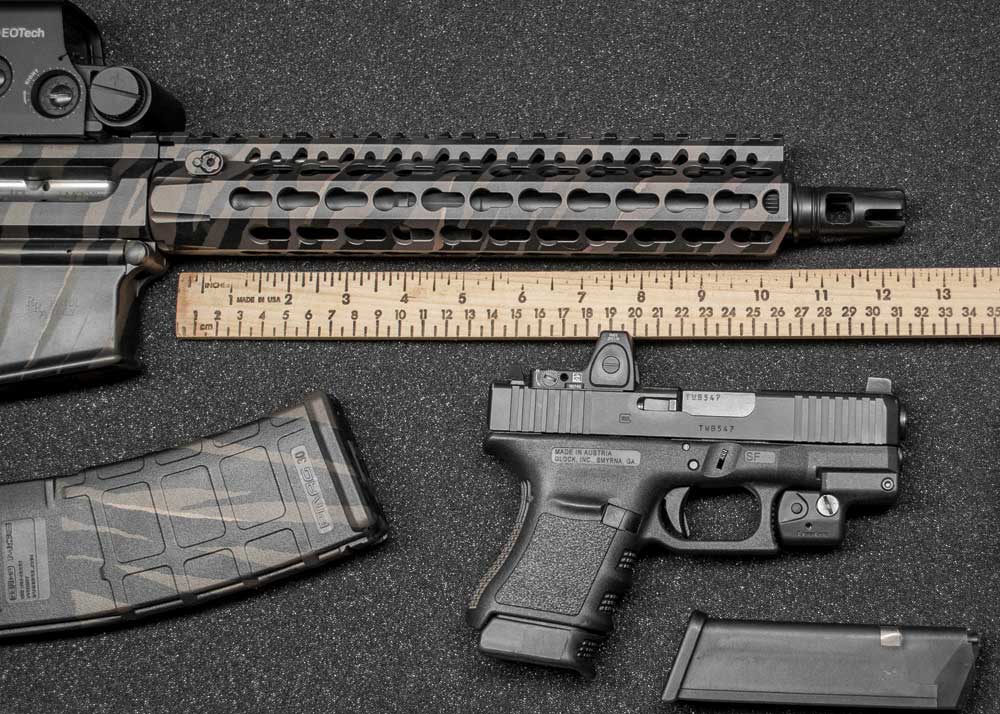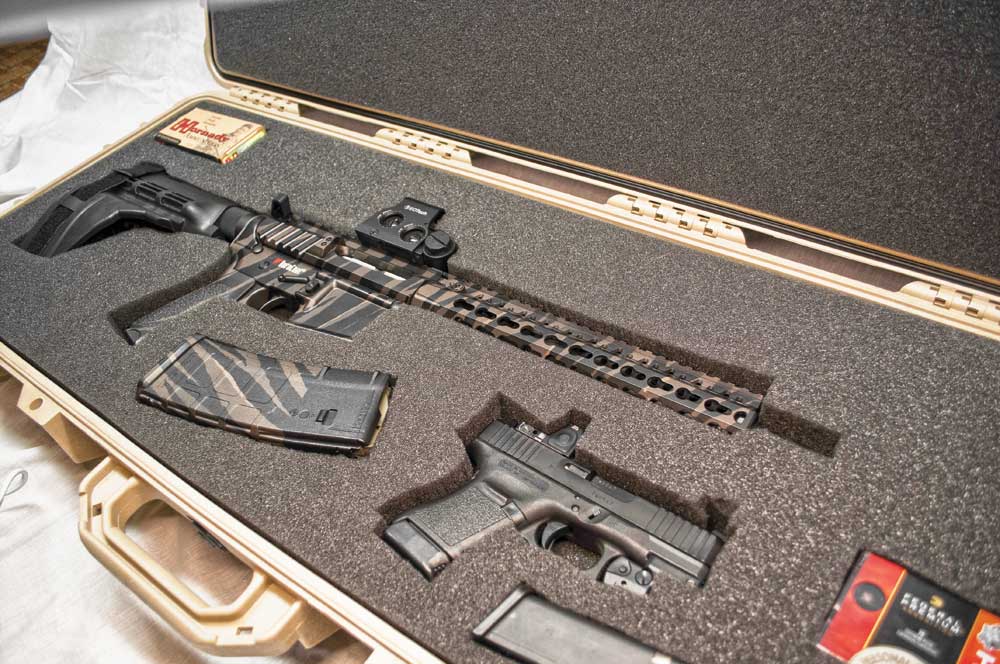
Having a case for your firearms is crucial in keeping them protected and secure. Check out these 14 easy steps for building a custom gun case.
How do you build the ultimate Pelican gun case?
- Choose the right case and type of foam for your needs, and ensure your firearm(s) is(are) unloaded.
- Lay out firearms and accessories how you want them to be, leaving at least an inch between objects, and then trace around them with a permanent marker.
- Take the foam out of the case and, using a sharp knife that's long enough to cut all the way through the foam but small enough to be maneuverable, cut the foam along the trace lines.
- Make any final cuts if needed to ensure proper fit and then glue the bottom two foam slabs together if you're certain you don't want to add any more cuts to the foam.
A beautiful gun deserves a beautiful gun case.
Watertight, airtight, dent-resistant and shatter-resistant — just a few ways to describe the practically indestructible nature of Pelican cases. These properties result in an ideal transportation system for firearms during air travel or backcountry adventures. Though some may argue the design of any gun case is no match for a thief with the right tools, Pelican cases keep honest people honest while protecting your favorite firearms.
Designed with a reinforced polypropylene shell that would make a crash test dummy jealous, Pelican cases have earned the trust of everyone from photographers to the U.S. military and its strict specifications. Beyond the polymer shell, the exterior of these cases also includes tamper-proof hinges, stainless steel padlock eyelets and even a pressure equalization valve. But the Pelican’s impressive exterior shell is only half of the equation.
 Popping open four double-throw latches, you’ll soon realize where the real magic happens. Beyond a rubber o-ring seal lay three dense pads of polyurethane foam. These slabs of foam line the top and bottom of the case, providing the cushioning necessary to protect firearms and gear from turbulence. In its factory-new configuration, the foam slabs are an open canvas waiting to be carved with the custom-cut dimensions of rifles, shotguns, handguns, ammo or accessories.
Popping open four double-throw latches, you’ll soon realize where the real magic happens. Beyond a rubber o-ring seal lay three dense pads of polyurethane foam. These slabs of foam line the top and bottom of the case, providing the cushioning necessary to protect firearms and gear from turbulence. In its factory-new configuration, the foam slabs are an open canvas waiting to be carved with the custom-cut dimensions of rifles, shotguns, handguns, ammo or accessories.
Don’t let the Pelican’s sophisticated design prevent you from transforming it into the perfect travel companion for your guns and gear. Luckily, personalizing your own Pelican gun case with custom-cut foam is a simple DIY project that requires very few tools and minimal expertise.
We’ve made it easier than ever to customize a Pelican case with the following step-by-step guide to building the ultimate gun case.
 1. Choose a Pelican Case That Best Suits Your Needs.
1. Choose a Pelican Case That Best Suits Your Needs.
Depending on what you want to transport, Pelican makes hundreds of cases in a variety of sizes. Be sure to measure the overall length of the firearm intended for the case, and then refer to Pelican’s website to check the interior dimensions of the desired gun case.
You should also take into account airline baggage size requirements. Many gun cases exceed the established oversize bag size set by commercial airlines, making them subject to expensive baggage fees. The most common airline oversize bag threshold is 62-inches, which is the total sum of an item’s length, width and height. Exceeding this threshold may result in additional fees. After researching, it appears the largest Pelican case for transporting long guns with 34 inches or less of overall length that fits under this threshold is the Pelican 1700 case, which was customized in the following steps.
TIP: If your gun is longer than 34 inches overall, consider field stripping it so it fits into the Pelican 1700 or a smaller-sized case.
2. Start with a Blank Canvas.
Pelican sells cases with two types of foam: solid slabs and Pick N’ Pluck. For the most custom setup, use the solid slabs and cut them yourself. The Pick N’ Pluck is easy to use for rectangular objects but is not completely form fitting around curved edges or custom shapes.
3. Safety first.
Before laying out the case to your desired orientation, be sure your firearms are unloaded.
 4. Lay It Out.
4. Lay It Out.
Place objects on the solid slab of foam in the orientation you wish them to lay in the case. Depending on how the case will be most commonly carried, distribute the weight evenly so one side is not abnormally heavy. It’s also recommended to put the firearm’s buttstock on the wheel-end of the case so the weight of the firearm is evenly distributed while rolling the case.
5. Proper Spacing.
Keeping objects spaced at least 1 inch apart will provide adequate padding and protection. Consider adding more space between optics and fragile pieces, or less space between magazines, ammo or other accessories.
TIP: If possible, leave empty space so you can custom-cut more objects at a later date if you get a new suppressor or want to allocate more space for ammunition.
6. Invert the Layout.
To hide the trace marks made in the next steps, invert your layout so the trace marks will be facing downward and not visible. This is not required but does make an aesthetic difference.
 7. Trace It Out.
7. Trace It Out.
Using a permanent marker, carefully trace around each object. Keep the trace marks close to the objects for a tighter fit. If you find the fit is too tight, you can always go back later and remove more foam.
TIP: Trace in a well-lit environment.
8. Choose Your Blade.
Cutting the foam with clean, precise lines requires the right knife for the job. Some sources suggest using serrated knives or an electric kitchen knife, but I find a 3- to 4-inch blade with a curved, pointed edge works best. It needs to be long enough to cut all the way through the foam but small enough for neat, precise cuts in tight areas.
9. Cut the Foam.
Pull the foam out of the case, and lay it on a table or work bench so the cutting area is hanging off the edge with an exposed underside for the knife to penetrate all the way through the foam. Following the trace marks from Step 7, cut the foam using straight up and down sawing motions. Start with the largest object, and cut one object at a time. Take it slow, and focus on making straight, clean cuts. Try to keep all the cuts in one continuous shape (more on this later).
TIP: The Pelican 1700 comes with three layers of foam. Only cut through one layer and go back later if you wish to cut the other layers to increase storage space.
 10. Final Cuts.
10. Final Cuts.
After completing the cuts, replace the foam into the case and add your guns, ammo and gear to check for proper fit. The items should fit snugly, yet not too tight where the foam pulls out when removing an item from the case.
TIP: If the fit is too tight, remove more foam in small increments for the most custom fit.
11. Keep the Cutouts.
Proper tracing and cutting technique leaves you with life-sized foam cutouts. Keep these cutouts so you can replace them into the foam slab as needed. Let’s say you’re going to the range and don’t want to bring your pistol; replace the foam cutout so you don’t have a big empty spot. Replacing the foam will increase the padding of nearby objects compared to leaving an empty spot.
12. Glue Bottom Foam Slabs Together.
Only do this once you’re certain you don’t want to add any more cuts to the foam. Gluing the two bottom slabs together will increase their functionality by keeping objects from slipping in-between them. Instead of two separate pieces, you’ll now have one solid piece of foam.
13. Lock It Up.
Now that your case is complete, you’ll want to lock it up while traveling. It’s suggested to purchase at least two locks per long gun case. If you are flying with firearms, make sure to buy locks that are not accessible by TSA. The author uses a matching set of four Master Lock Model 131Q locks for airline travel. They are sold in a single package and are all keyed to the same key. These locks are lightweight, yet strong enough to keep the honest people honest.
14. Multitasking.
Additional foam slabs are available for purchase aftermarket. Purchase another set of foam slabs to custom-cut them for other guns in your collection. That way one Pelican case can adapt to multiple guns just by changing between custom-cut foam slabs.
Editor's Note: This article is an excerpt from the Fall 2015 issue of Modern Shooter.

Next Step: Get your FREE Printable Target Pack
Enhance your shooting precision with our 62 MOA Targets, perfect for rifles and handguns. Crafted in collaboration with Storm Tactical for accuracy and versatility.
Subscribe to the Gun Digest email newsletter and get your downloadable target pack sent straight to your inbox. Stay updated with the latest firearms info in the industry.

![Best Concealed Carry Guns In 2025 [Field Tested] Wilson Combat EDC X9S 1](https://gundigest.com/wp-content/uploads/Wilson-Combat-EDC-X9S-1-324x160.jpg)


![Best 9mm Carbine: Affordable PCCs [Tested] Ruger Carbine Shooting](https://gundigest.com/wp-content/uploads/Ruger-Carbine-Shooting-100x70.jpg)
![Best AR-15: Top Options Available Today [Field Tested] Harrington and Richardson PSA XM177E2 feature](https://gundigest.com/wp-content/uploads/Harrington-and-Richardson-PSA-XM177E2-feature-100x70.jpg)
